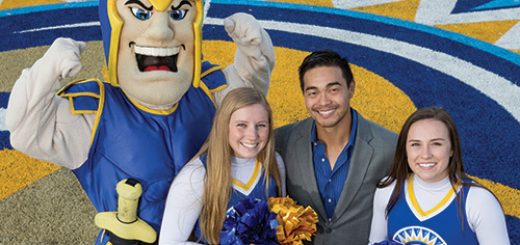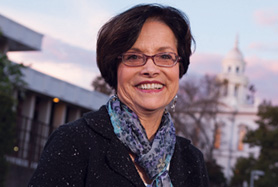Dreamers: The Undocumented Student and Immigrant Experience
Gloria “Tia” Immanuel, ’18 Business Administration, has not seen her biological parents or siblings since she was six years old, when she moved from Indonesia to a small town in southern California with her aunt and uncle. She had no idea that they had arrived on a six-month visa. It wasn’t until she was 15, when she asked her uncle to teach her to drive, that Immanuel learned that she is not an American citizen.

Photo: Thomas Sanders
“It took me six years to get to a university. Standing on this campus is always such an amazing moment, a proud moment. I made it. It doesn’t matter how long it takes. It’s just that you get there.”
“I never had anyone sit me down and say, unfortunately, you won’t be able to drive,” says Immanuel. “You won’t be able to get a license. You won’t be able to get a job. It was just me finding out and having to go through this on my own. I felt like there was no hope, no purpose. Why am I even here, if there is nothing being done about this?”
Immanuel is one of approximately 650 undocumented students at San Jose State this year. They represent various majors. Some are transfer students, some are undergraduates, some are graduate students. They are women and men of all ages. They speak many languages. Some are LGBTQ. They come from 19 countries.
Some undocumented students qualify for AB540 and AB2000, California legislation that allows undocumented immigrants who have attended elementary, middle or high school in state for at least three years to pay in-state tuition. The California Dream Act, passed in 2011, made it possible for undocumented students meeting specific requirements to qualify for state-funded financial aid. Those who do not qualify must pay non-resident student fees, including tuition plus an additional $372 per unit, as of spring 2017. Some of them, like Immanuel, have applied for two-year work permits through Deferred Action for Childhood Arrivals (DACA), a federal immigration policy introduced by President Obama in 2012. Unless undocumented immigrants have been granted DACA, they are not legally authorized to work.
Undocumented immigrants who pursue any of these options must sign an affidavit that discloses their immigration status to the government. Regardless of their status, they are united by a common goal: to pursue an education.
For Immanuel, her immigration status made the pathway to college unclear. When she graduated from high school, she didn’t qualify for financial aid, so she had to pay for every credit out of pocket. She worked as a babysitter while chipping away at her associate’s degree in business at San Bernardino Valley College. In 2012, when her sister moved to San Jose with her husband and small child, they invited her to move in with them, and offered to pay her to babysit while she went to school. She enrolled at Evergreen Valley College and first learned about DACA through the Asian Law Alliance, a nonprofit that serves the immigrant community. For the first time, she felt like she could make a concrete plan for her future.
“Moving to San Jose was one of the best decisions I ever made,” she says. “Coming here opened up the possibilities of DACA, and introduced me to the Asian Law Alliance, which has really helped and supported me through this whole journey. During my first two years at Evergreen, I worked and saved up most of my paychecks so that I could come to San Jose State. Then I learned about the [California] Dream Act, which helped, essentially, finance my schooling and made this dream possible.”
Now 24, she works 30 hours a week at Sears while juggling a full course schedule. Two weeks before President Donald Trump’s inauguration, she spoke at an immigrant rights rally outside San Jose City Hall. She said that although she was “afraid to lose her rights as a human,” she encouraged others to “have hope, despite any uncertainty that is to come.”
Creating Leaders
In 2015, the Institute for Immigration, Globalization and Education at the University of California at Los Angeles released a study entitled “In the Shadows of the Ivory Tower: Undocumented Undergraduates and the Liminal State of Immigration Reform.” The report revealed that undocumented college students experience high levels of anxiety, despite performing well academically. Seventy-six percent of those surveyed worried about being deported or detained, while 86 percent of students at four-year public colleges had a GPA over 3.0. These findings reflect the charged atmosphere that students like Immanuel confront while trying to finish a degree.
“I’m trying to fight for my DACA status, or any sort of legal status,” Immanuel says. “It’s a lot to juggle. Not only do you have work, you have school, you have this mental and physical breakdown of wondering, am I ever going to make it out of college? Am I ever going to find a good job? Is my status going to prevent me from doing what I want to do? These are questions I have to face every single day.”
Once California legislation made it possible for certain undocumented students to qualify for in-state tuition, the community of undocumented students on campus began to organize. San Jose State admitted its first cohort of 34 AB540 students in 2003.

Photo: Thomas Sanders
“There have been undocumented students forever, as long as we have had undocumented immigration,” says Julia Curry Rodríguez, associate professor of Mexican American Studies and immigrant rights scholar. “Our point of view about immigrants needs to be dynamic, not stereotypical and not based on myths. My concern is that undocumented students are not in a protected class, even though they are also women, they are also LGBTQ…That means that at some point, an undocumented person who belongs to one of these communities could be denied protection, and when that happens, it’s pretty dramatic.”
In 2004, Saúl Verduzco, ’03 Physiology, ’10 MS Biological Sciences, founded Student Advocates for Higher Education (SAHE), a student-run organization dedicated to creating a supportive advocacy network for students of all immigration status on campus.
“When Verduzco founded SAHE, the intention was to educate other students, from middle school on, about AB540,” says Curry Rodríguez. “If you are an immigrant family, do people view you as producing scholars? He wanted undocumented students to know that college was an option—and that they should plan for it.”
Since its founding, SAHE has awarded more than $20,000 in scholarships to undocumented students on campus. Francisco Villegas, ’06 MS Mexican American Studies, says that the organization was one of the two places on campus where he felt recognized and safe—the other space being Curry Rodríguez’s office.
“SAHE was a blessing,” he says. “It was the first place where I could talk about the stress of being undocumented. In my master’s thesis, I talked about an ongoing struggle between hope and hopelessness, which is how I frame the undocumented student experience. You have the hope of education as the great equalizer, access to the so-called American dream. And yet the more you learn about the effects of being undocumented, the more hopeless you become.”
After completing his master’s degree, he was accepted to a PhD program at the University of Toronto. Though this afforded him the opportunity to complete his degree, it came at great sacrifice. When undocumented individuals leave the United States, they are not allowed to return for 10 years. This meant missing weddings, births and graduations, and kept him from interviewing for competitive faculty positions.
“Our point of view about immigrants needs to be dynamic, not stereotypical and not based on myths.”
In 2016, Villegas accepted a position as assistant professor of sociology and anthropology at Kalamazoo College in Michigan, where he specializes in immigration, race, citizenship, deportability and illegalization. He says it is critical that undocumented students have a space on campus to navigate the complexity of their immigration status, as well as everyday challenges such as getting to class, finding affordable housing and caring for their families. A growing number of University of California and California State University campuses have created so-called “dreamer centers” to accommodate this need.
“How do we develop a space where our undocumented students feel like they belong?” Villegas asks. “How do we get them to adopt a sense of Spartan pride? We need to develop centers that remain reflexive and continue to recognize an ever-changing context, forever reimagining inclusion and exclusion.”
A Place to Dream
In 2015, SJSU Associated Students unanimously passed a resolution to develop an Undocumented and Immigrant Student Resource Center on campus. Among the goals of the resolution are to provide staff and faculty training on the needs of undocumented students and to partner with local law schools and nonprofits to provide legal assistance for students. Immanuel is a member of the committee working to develop the center.
“I want this resource center to be a shining beacon of hope for undocumented students,” Immanuel says. “I want them to feel safe and to get help, something I feel like I have been trying to find in a school for a long time. This center isn’t just for other students; it’s for me too. I’ll know where to go to find out about scholarships and financial aid. I can’t tell you how excited I am.”
Her career goal? To open a nonprofit similar to Asian Law Alliance in Colton, her hometown.
“There is an undocumented student community out there that could definitely benefit from a lot of the services I obtained,” she says. “It took me six years to get to a university. Standing on this campus is always such an amazing moment, a proud moment. I made it. It doesn’t matter how long it takes. It’s just that you get there.”





Great story! Thank you for shedding light on this topic.
Beautiful story! Thank you for putting the spotlight on those who have to go above and beyond to obtain higher education and basic rights that are often taken by granted by most citizens in this country.